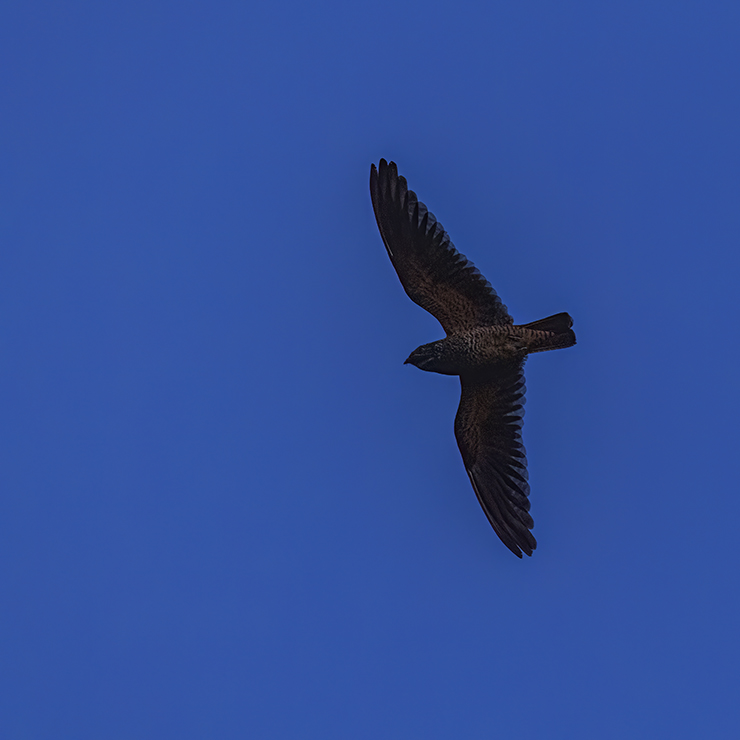
As mentioned in many other posts on this blog, the avifauna of Trinidad & Tobago consists of several species and family groups occurring very interestingly, in threes. I hadn’t noticed this until I began compiling my own book on the birds of T&T some years ago, and I thought it rather uncanny. The last time I spoke about this was over a year ago, and if you’re doubting the prevalence of this, take a look at this list:
Bitterns | Trogons | Antshrikes | Spinetails | Manakins | Hermits | Honeycreepers | Warblers | Myiarchus
Over the last few days we have been enjoying daily – or should I say nightly – sightings of Short-tailed Nighthawk. A pair has been roosting near to where we are currently living, and each evening these cryptic birds take to the wing in search of flying insects. I have been unable to find a day roost despite my best efforts. Photographing these nocturnal rockets has proven to be quite the challenge, I don’t think I’ve ever furiously deleted so many images in my life.

Short-tailed Nighthawk (above and below)

Overall, this species seems to be poorly known, which is understandable given its habits. Typically, they wait for the sun to be comfortably below the horizon before rousing in any manner. They have not been observed to call from the roost; a single bird silently takes to the wing, dropping almost vertically out of its roost tree. It then flies around for a few minutes until it is joined by the second bird; this is when the vocalizations begin. Over the course of usually the next twenty minutes (or however long it takes for darkness to tightly grip the scene) the pair chases insects and each other, all the while making a variety of chirps and buzzes.

Photographing the Short-tailed Nighthawks involved exercises firstly in tracking their rapid, erratic and incredibly bat-like flight, and secondly in processing the remaining images once 99.99% were deleted.
One evening while looking at the nighthawks, I noted the presence of a third bird. Similarly sized and proportioned to the nighthawks, this one decided to perch on an exposed snag. Unbelievable, I thought – was this my chance to finally land a decent photo of this species? To my naked eyes in the darkness its cream throat seemed a little off for a nighthawk, but perhaps it was a juvenile? Once I looked through proper glass however, all doubt was blown to smithereens – it was a Bat Falcon.

When this Bat Falcon departed this perch, it made the Short-tailed Nighthawks seem like they were running on low-octane fuel.
All of this to say that finally I have documented all three species of nighthawk found in T&T. Well, kind of. A couple years ago some birders photographed a strange looking nighthawk that was within a small flock of Lesser Nighthawks; this bird is yet to be identified but is either Antillean or Common Nighthawk. For my selfish purposes of collecting threes, I’m not including this mystery here.
The first Lesser Nighthawks I saw were from a mall carpark; the birds would gather in great number to feast on the many insects attracted by the nauseating (to me) floodlights. I tried photographing them at that time; the results were embarrassing.
Many years later, I heard of another group of Lesser Nighthawks that had converged on a nearby wetland. After a failed attempt to find a day roost, I tried another morning with a different strategy. Arriving in the darkness of the pre-dawn, I simply waited for the birds to return to their roost. I wish life was always this easy.

Lesser Nighthawk
Rounding off the three is the largest of the bunch, the mighty Nacunda Nighthawk. This was actually the first nighthawk I saw properly, many years ago at dawn. Over the course of the next decade, they have been fairly regular visitors to a wetland in the south of Trinidad and are one of the easier nocturnal species to observe during the right time of year.

Nacunda Nighthawk
It must be noted that no calls or other lures were used to photograph any of these birds, and that sleeping birds were left in place to rest for as long as they desired.













The bat falcon is a real beauty … congratulations!
Thank you! Always a pleasure to see.